Abstract
Two-dimensional paper chromatography in four solvent systems, high-sensitivity spray reagents, and UV absorption spectroscopy were used to separate and characterize flavonoids and isoflavonoids in roots and root nodules of 20-d-old Lotus pedunculatus Cav. Seedlings were grown either under sterile conditions or after inoculation with Fix+ or Fix− strains of Rhizobium loti. Flavonoids rather than isoflavonoids predominated in all tissues. Flavonoid profiles in sterile and denodulated root tissues were remarkably similar, both qualitatively and quantitatively. At least 14 partially purified flavonoid aglycones and conjugates were found in root extracts; denodulated root tissues contained no compounds that were not also present in sterile roots. Fix+ rhizobia were responsible for major postinfection shifts in plant flavonoid biosynthesis at the sites of nodule morphogenesis. Polymeric flavolans were absent from Fix+ nodules but present in all root tissues and in Fix− nodules. Catechin was detected only in Fix+ nodules.
Full text
PDF
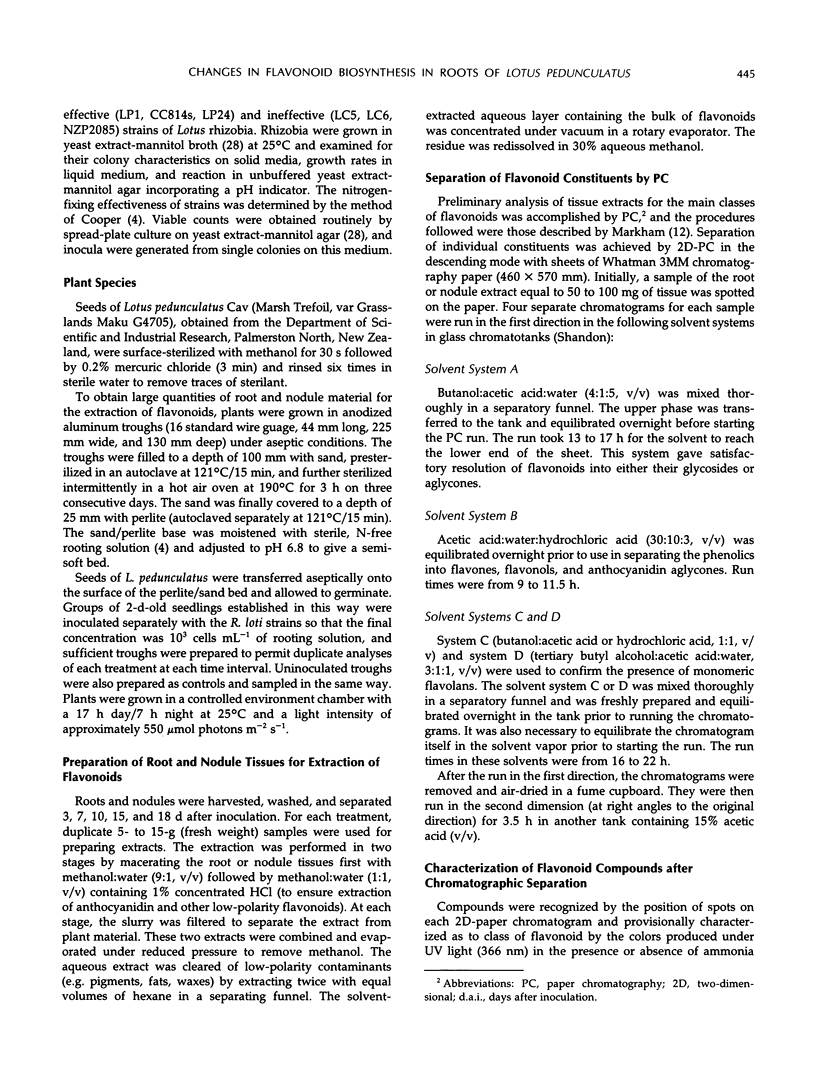
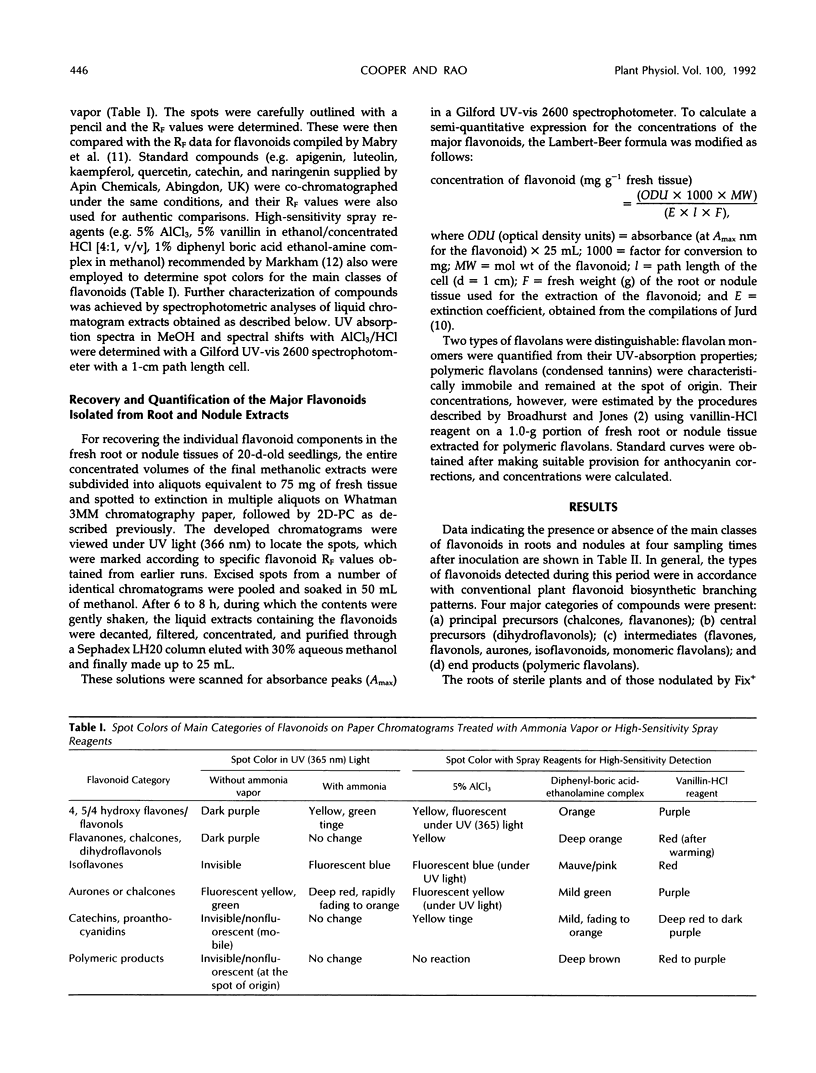
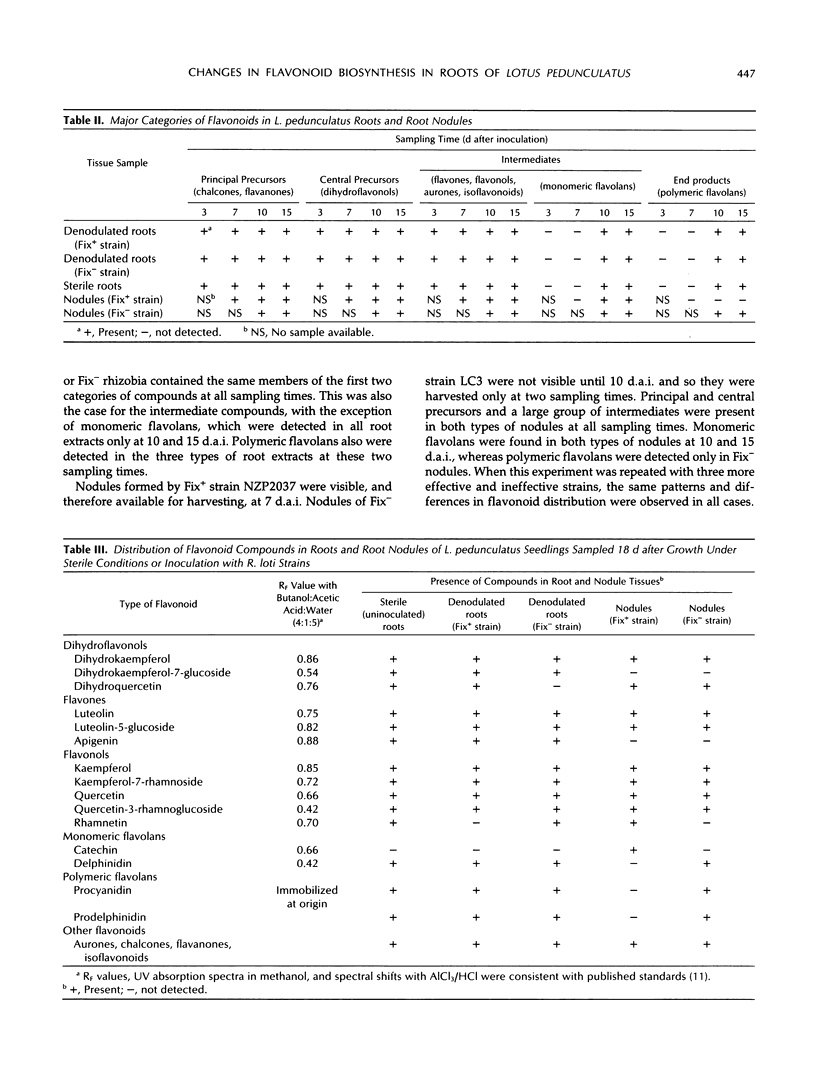
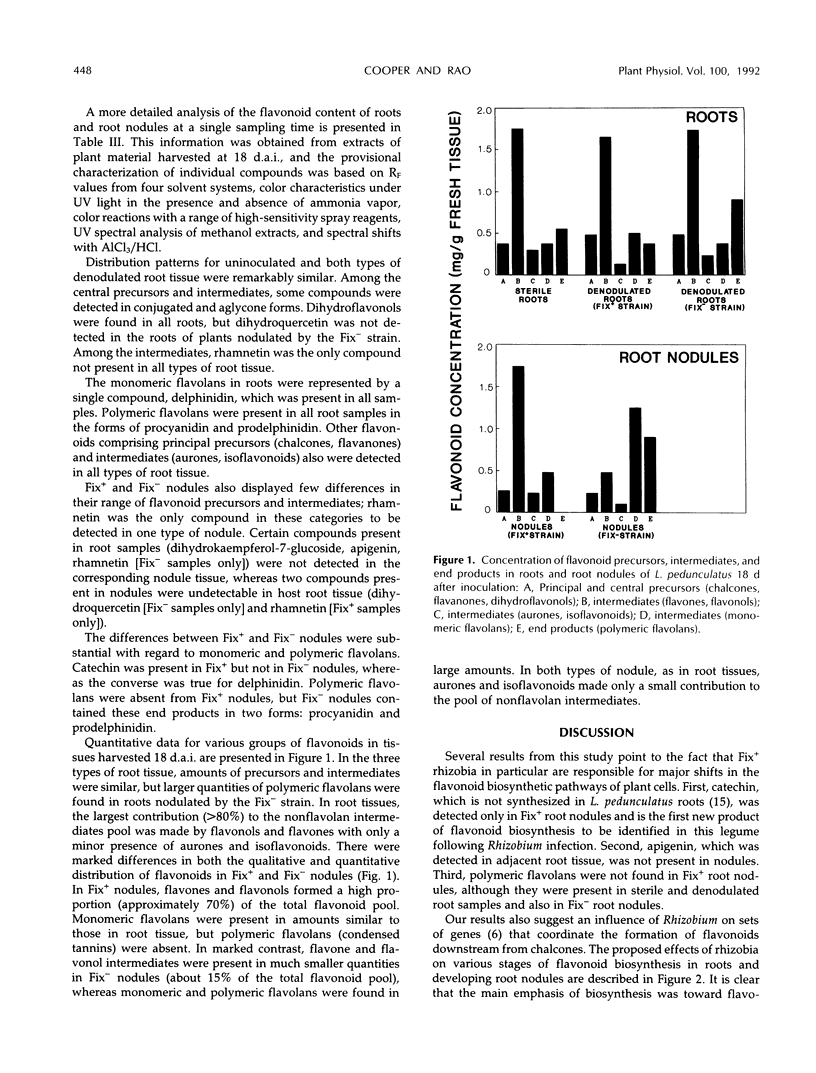
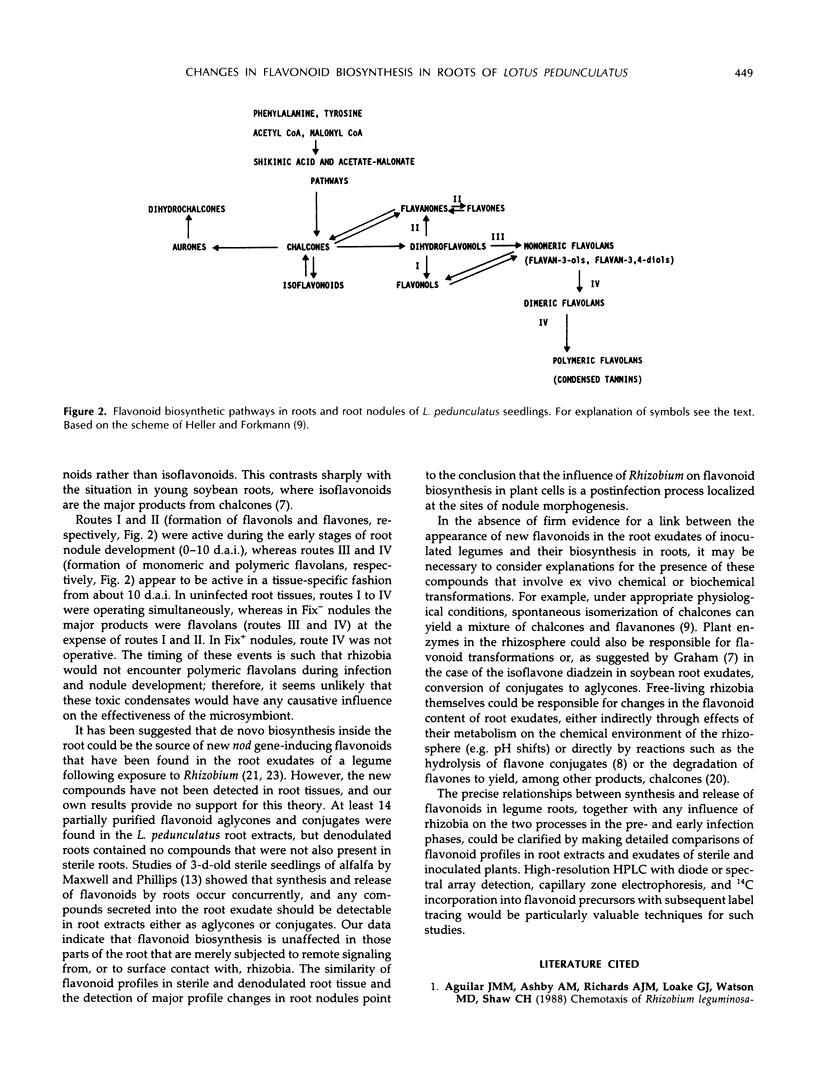
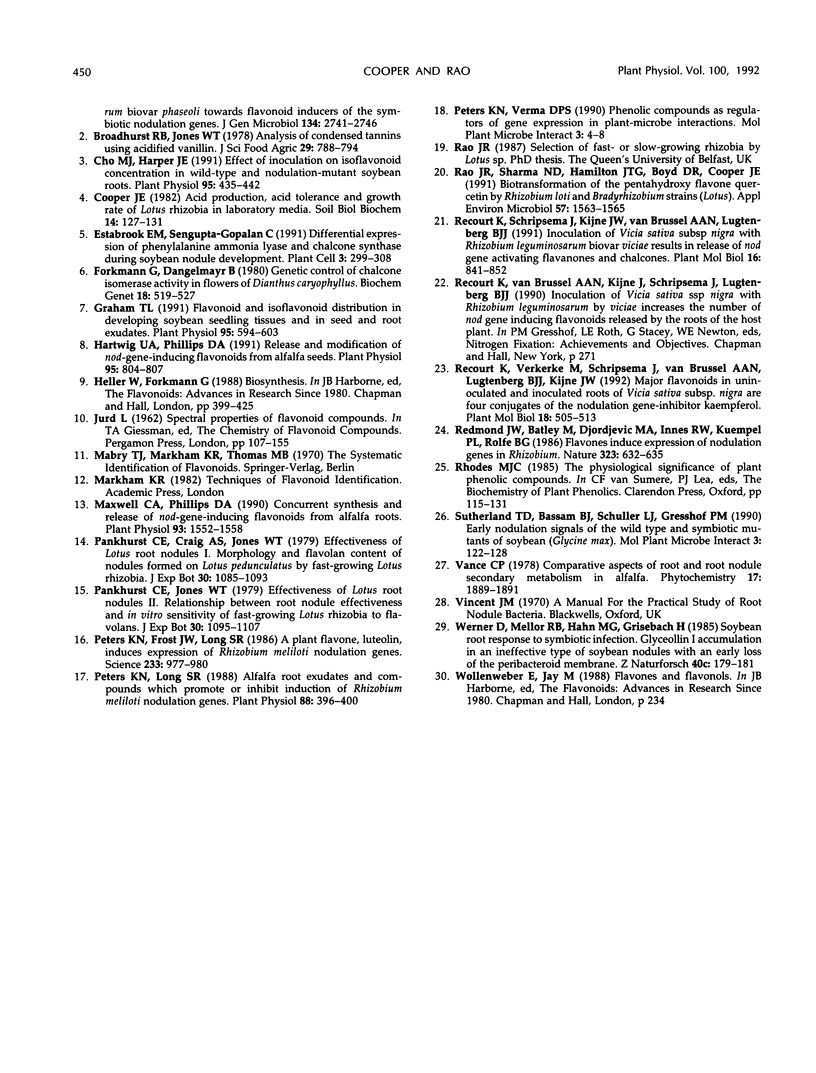
Selected References
These references are in PubMed. This may not be the complete list of references from this article.
- Cho M. J., Harper J. E. Effect of inoculation and nitrogen on isoflavonoid concentration in wild-type and nodulation-mutant soybean roots. Plant Physiol. 1991 Feb;95(2):435–442. doi: 10.1104/pp.95.2.435. [DOI] [PMC free article] [PubMed] [Google Scholar]
- Estabrook E. M., Sengupta-Gopalan C. Differential expression of phenylalanine ammonia-lyase and chalcone synthase during soybean nodule development. Plant Cell. 1991 Mar;3(3):299–308. doi: 10.1105/tpc.3.3.299. [DOI] [PMC free article] [PubMed] [Google Scholar]
- Forkmann G., Dangelmayr B. Genetic control of chalcone isomerase activity in flowers of Dianthus caryophyllus. Biochem Genet. 1980 Jun;18(5-6):519–527. doi: 10.1007/BF00484399. [DOI] [PubMed] [Google Scholar]
- Graham T. L. Flavonoid and isoflavonoid distribution in developing soybean seedling tissues and in seed and root exudates. Plant Physiol. 1991 Feb;95(2):594–603. doi: 10.1104/pp.95.2.594. [DOI] [PMC free article] [PubMed] [Google Scholar]
- Hartwig U. A., Phillips D. A. Release and Modification of nod-Gene-Inducing Flavonoids from Alfalfa Seeds. Plant Physiol. 1991 Mar;95(3):804–807. doi: 10.1104/pp.95.3.804. [DOI] [PMC free article] [PubMed] [Google Scholar]
- Maxwell C. A., Phillips D. A. Concurrent Synthesis and Release of nod-Gene-Inducing Flavonoids from Alfalfa Roots. Plant Physiol. 1990 Aug;93(4):1552–1558. doi: 10.1104/pp.93.4.1552. [DOI] [PMC free article] [PubMed] [Google Scholar]
- Peters N. K., Frost J. W., Long S. R. A plant flavone, luteolin, induces expression of Rhizobium meliloti nodulation genes. Science. 1986 Aug 29;233(4767):977–980. doi: 10.1126/science.3738520. [DOI] [PubMed] [Google Scholar]
- Peters N. K., Long S. R. Alfalfa Root Exudates and Compounds which Promote or Inhibit Induction of Rhizobium meliloti Nodulation Genes. Plant Physiol. 1988 Oct;88(2):396–400. doi: 10.1104/pp.88.2.396. [DOI] [PMC free article] [PubMed] [Google Scholar]
- Peters N. K., Verma D. P. Phenolic compounds as regulators of gene expression in plant-microbe relations. Mol Plant Microbe Interact. 1990 Jan-Feb;3(1):4–8. doi: 10.1094/mpmi-3-004. [DOI] [PubMed] [Google Scholar]
- Rao J. R., Sharma N. D., Hamilton J. T., Boyd D. R., Cooper J. E. Biotransformation of the Pentahydroxy Flavone Quercetin by Rhizobium loti and Bradyrhizobium Strains (Lotus). Appl Environ Microbiol. 1991 May;57(5):1563–1565. doi: 10.1128/aem.57.5.1563-1565.1991. [DOI] [PMC free article] [PubMed] [Google Scholar]
- Recourt K., Schripsema J., Kijne J. W., van Brussel A. A., Lugtenberg B. J. Inoculation of Vicia sativa subsp. nigra roots with Rhizobium leguminosarum biovar viciae results in release of nod gene activating flavanones and chalcones. Plant Mol Biol. 1991 May;16(5):841–852. doi: 10.1007/BF00015076. [DOI] [PubMed] [Google Scholar]
- Recourt K., Verkerke M., Schripsema J., van Brussel A. A., Lugtenberg B. J., Kijne J. W. Major flavonoids in uninoculated and inoculated roots of Vicia sativa subsp. nigra are four conjugates of the nodulation gene-inhibitor kaempferol. Plant Mol Biol. 1992 Feb;18(3):505–513. doi: 10.1007/BF00040666. [DOI] [PubMed] [Google Scholar]


